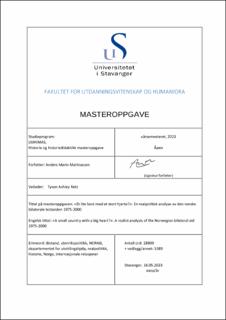| dc.contributor.advisor | Retz, Tyson Ashley | |
| dc.contributor.author | Mathiassen, Anders Marin | |
| dc.date.accessioned | 2023-07-06T15:51:16Z | |
| dc.date.available | 2023-07-06T15:51:16Z | |
| dc.date.issued | 2023 | |
| dc.identifier | no.uis:inspera:146752593:37186065 | |
| dc.identifier.uri | https://hdl.handle.net/11250/3076650 | |
| dc.description.abstract | Denne oppgaven undersøker hvordan den norske bilaterale bistanden har endret seg i perioden 1975-2000, med en vinkling på endringene etter Sovjetunionens fall. For å svare på hvordan endringer har skjedd, har det vært viktig å gi et svar på hvorfor endringene skjedde. Oppgaven bruker realpolitisk teori for å undersøke hvorfor endringene skjedde. Oppgavens kildegrunnlag er årsrapporter fra NORAD, arkivmateriale fra departementet for utviklingshjelp og relevante stortingsmeldinger i periode.
Problemstillingen denne oppgaven har foretatt seg er: Hvordan har den bilaterale bistanden endret seg fra perioden 1975 til 2000, og kan man se en endring av norsk bistand etter Sovjetunionens fall?
For å svare på oppgavens spørsmål har jeg brukt Dunne og Schmidts «essential realism» og «Democratic peace theory» fra Kants verk. For å fylle ut det som mangler om bistandshistorien fra kildegrunnlaget har oppgaven tatt i bruk tidligere forskning fra flere forskere, som Pharo, Simensen, Balsvik og Stokke.
Oppgavens funn gir et bilde på den norske bilaterale bistanden som tosidig. Både altruistiske motiver og egennytte kan finnes igjen i bistanden mellom 1975-2000. Etter Sovjetunionens oppløsning kan man finne et skifte i den norske bistanden, der man gikk fra et perspektiv på å hjelpe de fattigste i de fattigste landene, til å ha et mål om å bygge opp landenes institusjoner og demokratibygging i mottakerlandene. Endringen kan tilsies det endrede maktskiftet i den geopolitiske maktbalansen. | |
| dc.description.abstract | This thesis examines how Norwegian bilateral aid has changed during the period of 1975-2000, with a focus on changes following the fall of the Soviet Union. To answer how these changes occurred, it has been important to provide an answer as to why they occurred. Political realist theory is used to investigate why these changes happened. The source material for this thesis includes annual reports from NORAD, archival material from the Ministry of Development Aid, and relevant white papers from the period.
The research question of this thesis is: How has bilateral aid changed from the period of 1975 to 2000, and can we observe a change in Norwegian aid after the fall of the Soviet Union?
To answer this question, this thesis utilizes Dunne and Schmidt's "essential realism" and Kant's "Democratic peace theory". Additionally, to supplement the information regarding aid history from the source material, this thesis incorporates previous research from several scholars such as Pharo, Simensen, Balsvik, and Stokke.
The findings of this thesis paint a picture of Norwegian bilateral aid as twofold. Both altruistic motives and self-interest can be found in aid between 1975-2000. After the dissolution of the Soviet Union, a shift can be observed in Norwegian aid, where the perspective changed from helping the poorest in the poorest countries, to a goal of building up institutions and democracy in recipient countries. This change can be attributed to the shift in the geopolitical power balance. | |
| dc.language | nob | |
| dc.publisher | uis | |
| dc.title | «Et lite land med et stort hjerte?»: En realpolitisk analyse av den norske bilaterale bistanden 1975-2000 | |
| dc.type | Master thesis | |
